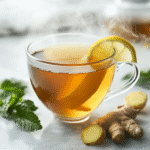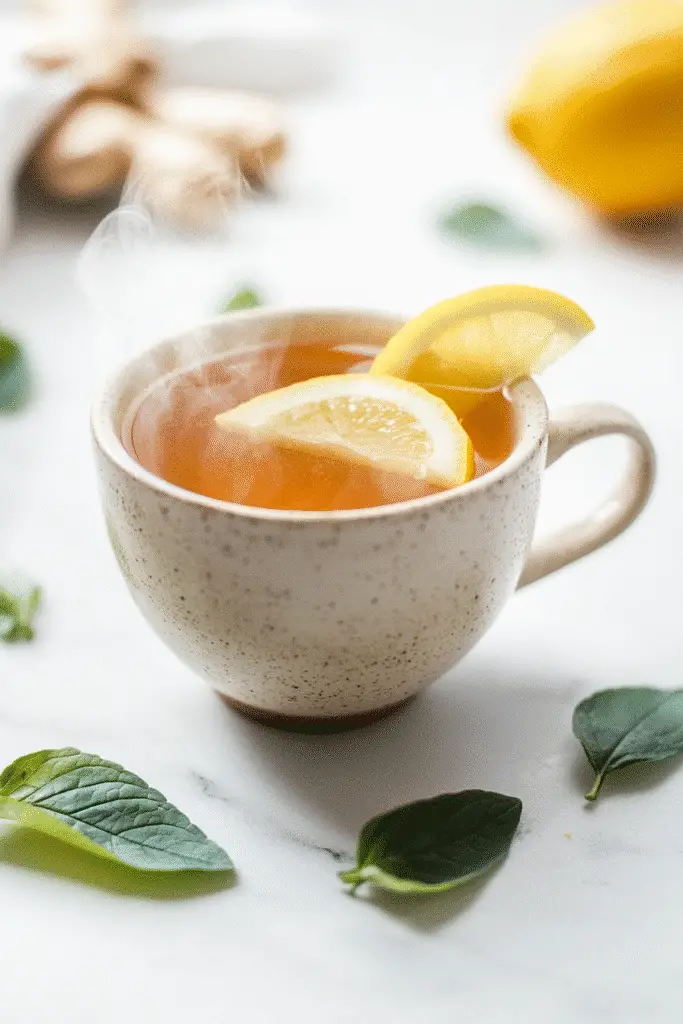Lemon Balm Recipe for Weight Loss, an herbal tea that’s as calming as it is cleansing.

I remember the first time I steeped lemon balm leaves on a rainy afternoon in Provence — the citrusy aroma filled the room like a soft exhale. I wasn’t trying to “lose weight” in that moment. I just wanted to feel lighter, calmer, clearer. Turns out, lemon balm has been doing just that for centuries.
This humble little herb — cousin to mint, kissed with lemon — is one of my favorite ingredients for creating rituals that support the body gently. If you’re managing stress eating, sleep struggles, or riding the waves of a new wellness medication like Ozempic, this tea meets you where you are.
And if you’re looking for more gentle, nourishing ways to support your body, you’ll love browsing my collection of healthy recipes for weight loss — each one crafted with care and soul.
What You’ll Find Here
What Is Lemon Balm Recipe for Weight Loss
How one calming cup can gently shift your weight journey — without willpower or restriction.
Lemon balm tea isn’t new. It’s ancient. But it’s having a moment right now — especially in wellness spaces and among folks managing weight through calming, sustainable rituals. And let me tell you — it’s not just hype.
This little herb, a member of the mint family, has been used for centuries in European herbal medicine to soothe the nervous system, support digestion, and even encourage sleep. It smells like lemon zest met fresh earth — bright, grounding, and instantly calming.
How does it help with weight loss?
Let’s keep it real: lemon balm is not a magic bullet. But it can absolutely support your weight goals by shifting some of the root triggers behind stubborn cravings and weight plateaus.
According to WebMD, lemon balm contains rosmarinic acid, which has antioxidant and anti-inflammatory effects. That supports your gut, your stress levels, and your immune system — all of which play roles in metabolism and emotional eating.
Here’s what makes it quietly powerful:
- Reduces Stress Cravings: Lemon balm may help lower cortisol levels, easing emotional eating and those “snack attack” moments tied to stress and fatigue.
- Improves Sleep, Reduces Cravings: Better sleep supports hunger hormones like leptin and ghrelin. Lemon balm tea before bed may help you rest deeper — and snack less.
- Creates Mindful Rituals: This tea isn’t about restriction. It invites you to slow down, breathe, and reconnect — which naturally shifts how and why you eat.
How to Make Lemon Balm Recipe for Weight Loss
A simple steep that supports digestion, reduces cravings, and centers your day.
This tea isn’t just a recipe — it’s a ritual. Whether you’re winding down at night, easing into your morning without caffeine, or managing appetite while on a GLP-1 journey, this blend meets you with grace and citrusy calm.
Print
Lemon Balm Recipe for Weight Loss
- Total Time: 15 minutes
- Yield: 2 servings 1x
- Diet: Vegan
Description
A calming, citrusy herbal tea that supports digestion, reduces cravings, and complements GLP-1 journeys. Perfect for morning rituals or evening wind-downs.
Ingredients
- 1 cup fresh lemon balm leaves (or 1 tablespoon dried)
- 1 teaspoon freshly grated ginger (optional)
- Juice of ½ lemon
- 2 cups filtered water
- 1 teaspoon raw honey (optional, or monk fruit for sugar-sensitive)
Instructions
- Boil the water in a kettle or small saucepan.
- Place the lemon balm and ginger in a teapot or infuser.
- Pour the hot water over the herbs.
- Cover and steep for 7–10 minutes.
- Strain into a mug or mason jar.
- Stir in lemon juice and sweetener if using.
- Enjoy warm or chill for an iced version.
Notes
For blood sugar balance, swap honey with monk fruit, stevia, or allulose. This tea is ideal for those managing appetite on a GLP-1 or diabetic-friendly plan.
- Prep Time: 5 minutes
- Cook Time: 10 minutes
- Category: Beverage
- Method: Steeping
- Cuisine: Herbal
Nutrition
- Serving Size: 1 cup
- Calories: 5
- Sugar: 0
- Sodium: 0
- Fat: 0
- Saturated Fat: 0
- Unsaturated Fat: 0
- Trans Fat: 0
- Carbohydrates: 1
- Fiber: 0
- Protein: 0
- Cholesterol: 0
Keywords: lemon balm tea, weight loss tea, herbal tea, digestion, GLP-1 support
Ingredients:
- 1 cup fresh lemon balm leaves (or 1 tablespoon dried)
- 1 teaspoon freshly grated ginger (optional, but adds a gentle metabolic kick)
- Juice of ½ lemon (brightens the flavor and offers vitamin C support)
- 2 cups filtered water
- 1 teaspoon raw honey (optional — or swap for monk fruit if sugar-sensitive)
Directions:
- Boil the water in a kettle or small saucepan.
- Place the lemon balm and ginger in a teapot or infuser.
- Pour the hot water over the herbs.
- Cover and steep for 7–10 minutes. Let the aroma slow you down.
- Strain into your favorite mug or mason jar.
- Stir in lemon juice and sweetener, if using.
- Sip warm… or chill it for a refreshing iced version.
For Blood Sugar Balance (Ozempic, Diabetic-Friendly):
- Swap honey for monk fruit, stevia, or allulose.
- You still get the comfort — just without the spike.
Tiffany’s Tea Tip:
Add a bit of lemon zest while steeping for an extra fragrant finish — it makes your kitchen smell like sunshine.
If you’re exploring calming recipes that support GLP-1 journeys like Mounjaro, my Japanese Mounjaro Recipe is a gentle favorite rooted in tradition and balance.
How Lemon Balm Helps With Cravings, Hormones & Digestion
Weight loss isn’t just about willpower. It’s about nervous system support.
I’ll be honest — when I first started my wellness journey, I thought success came from cutting more, doing more, pushing harder. But over time, I learned that gentleness is often the missing ingredient. That’s where lemon balm tea shines.

You see, this isn’t just about metabolism — it’s about your mind, mood, and gut. Lemon balm gently supports all three, helping your body shift from “fight-or-flight” to rest, digest, and reset. And that changes everything.
Yes — it really can help reduce emotional cravings.
If you’re someone who eats when you’re stressed, lemon balm may help break that loop.
Here’s how:
- Cortisol, your stress hormone, tends to spike after emotional upheaval, lack of sleep, or even scrolling too much.
- Those spikes tell your body, “Store fat. Feed me sugar. Keep me safe.”
- Lemon balm has been shown to naturally regulate cortisol, calming your nervous system so you don’t need that extra cookie just to feel okay.
Drinking it before meals — or especially before bed — helps signal to your body that you’re safe, nourished, and in no danger. That’s powerful for long-term, sustainable weight balance.
Better sleep = better hormones = better choices
You can eat the most balanced meals all day, but if you’re not sleeping, your body will still crave sugar and salt like it’s surviving a famine.
As Glamour notes, lemon balm tea can improve sleep latency — meaning you fall asleep faster and sleep more deeply. That helps balance:
- Leptin (the “I’m full” hormone)
- Ghrelin (the “I’m hungry” hormone)
More rest also supports natural insulin regulation, according to Healthline, which can help reduce sugar cravings and mid-day energy crashes.
Gut health and digestion also get a boost
I like to think of lemon balm as the herb your belly’s been praying for.
When you drink it before or after a meal, it acts like a digestive ally — soothing bloat, easing gas, and encouraging smooth gut motility. That’s key for:
- Nutrient absorption
- Bloating relief
- Regularity and detox
And it’s gentle, y’all. Not like some trendy “cleanses” that leave you running for the bathroom. This is slow, sustainable support.
Who It’s For:
- Folks struggling with late-night cravings or emotional eating
- Anyone taking Ozempic or Wegovy, looking for caffeine-free, natural support
- Busy professionals or moms needing a moment of calm during the day
- Those working on gut health, hormone healing, or better sleep
When Should You Drink It?
Morning: to gently awaken the body
Before meals: to aid digestion and prevent overeating
Evening: to wind down, reduce cortisol, and prevent late-night snacking
Try pairing this with my Cortisol Tea Recipe for Weight Loss for a stress-soothing routine that works from the inside out.
Lemon Balm Recipe Variations
One base recipe. Many paths to support your body — and your taste buds.
Once you’ve tried lemon balm tea on its own, the real fun begins. You can easily adapt this recipe into something that feels seasonal, personalized, and even more functional.
I like to think of this tea as a canvas. Depending on what your body needs—gentle energy, digestion support, blood sugar balance—there’s a variation that fits. Below are my favorite ways to build on the core recipe using herbs, fruits, and spices that pair beautifully with lemon balm.
Green Tea + Lemon Balm: Metabolism Boost
Add one green tea bag to your lemon balm and ginger blend during steeping.
Green tea brings gentle caffeine, catechins, and thermogenic benefits to support fat metabolism.
This variation works well in the morning or early afternoon, especially if you’re scaling back on coffee.
Cucumber-Infused Iced Lemon Balm Tea: Flat-Tummy Water
Steep the tea as usual, chill it, then add thin cucumber ribbons and let it sit in the fridge for 2 to 4 hours.
Hydrating, cooling, and naturally de-puffing. Great for warm days, hormone-related bloat, or post-travel recovery.
Lemon Balm + Cinnamon Stick: Blood Sugar Balance
Drop in a small cinnamon stick while steeping to support stable blood sugar and reduce sweet cravings.
Cinnamon and lemon balm together create a warming, grounding blend perfect for early evenings or colder seasons.
Lemon Balm + Mint: Digestion and Refreshment
Add a few fresh mint leaves with your lemon balm during steeping.
This classic combination aids digestion, supports liver function, and makes for a spa-like iced tea when chilled.
Lemon Balm + Lemon Zest: Deep Citrus Aroma
Grate a little lemon zest into the pot before pouring in hot water.
It brightens the blend naturally, without added sugars, and offers antioxidant support.
Especially helpful for those trying to cut back on honey or sweeteners.
Dandelion Root Add-In: Gentle Detox
If you’re working on liver health or fluid retention, add a teaspoon of dried dandelion root to the steep.
Dandelion and lemon balm pair beautifully, especially when sweetened lightly with monk fruit or licorice root.

When to Use These Variations
- Use green tea blends earlier in the day
- Cinnamon, mint, and cucumber blends are ideal around meals
- Zest or detox blends are great for mid-morning or late afternoon resets
For those navigating appetite changes on medications like Ozempic or Wegovy, these variations offer subtle ways to align your taste preferences with your wellness goals—without needing to rely on harsh stimulants or sugar-laden drinks.
You can also explore other recipes like my Bariatric Seed Trick Recipe to support weight loss through fiber and fullness.
When and How Often to Drink Lemon Balm Tea
Your body’s rhythm matters more than the clock.
One of the most common questions I get is, “When should I drink this tea to get the best results?”
And the truth is, it depends on you. Your body, your schedule, your stress patterns — they all shape how lemon balm will serve you best.
But there are definitely times when this tea can work a little harder for you.
Morning: A Gentle Start
If you’re easing off caffeine or supporting your nervous system first thing, lemon balm offers a calm, grounded alternative to coffee.
It won’t give you a jolt, but it will help reduce cortisol spikes that can lead to cravings later in the day.
Add a squeeze of lemon and a touch of ginger for warmth and digestive flow.
Before Meals: Support Digestion and Reduce Overeating
Sipping lemon balm tea 15–30 minutes before meals can help your body shift into “rest and digest” mode.
This is especially helpful if you tend to rush through lunch or struggle with bloating after dinner.
Adding mint or cinnamon here can further support digestion and blood sugar balance.
Evening: Reset the Cravings, Reclaim Your Rest
This is my personal favorite time to sip lemon balm.
After a long day, it signals to your body — and your brain — that you’re winding down.
It can help reduce late-night snacking urges, support hormone balance, and promote deep, restorative sleep.
How Often Should You Drink It?
For most people, 1 to 3 cups per day is enough.
- Morning for calm focus
- Afternoon for gut and mood balance
- Evening for cravings and sleep support
If you’re using GLP-1 medications like Ozempic or Wegovy and experiencing nausea or appetite loss, start with half a cup and go slowly.
Listen to your body. Some folks thrive on a daily ritual, others benefit from just a few calming cups per week.
You can pair this with my Frozen Wegovy Recipe for a supportive, refreshing option when your body needs hydration and balance.
FAQs
Does lemon balm help lose belly fat?
Yes, indirectly. Lemon balm won’t melt fat on its own, but it supports your body’s natural balance in ways that can reduce belly weight over time. When you’re under chronic stress, your body often holds onto fat in the midsection. Lemon balm may help lower cortisol, your primary stress hormone, which plays a big role in where your body stores fat. It also supports better sleep and digestion, both of which affect how your body burns and holds onto weight. So while it’s not a quick fix, it is a meaningful part of a long-term wellness strategy.
What can you make with lemon balm?
You can use lemon balm in far more than tea. It works beautifully in citrusy herbal infusions, especially when paired with mint, cucumber, or lavender. Many people steep it into a syrup for cocktails or mocktails, blend it into herb vinaigrettes, or add it to light pestos for fish and grain bowls. It also makes a lovely infused honey or oil. And in the summer, chilled lemon balm tea can even be turned into herbal popsicles for a refreshing, no-sugar treat.
How to drink lemon balm tea for weight loss?
For weight support, drink lemon balm tea one to three times a day based on your body’s needs. In the morning, it can help you start calm and focused without the crash of caffeine. Before meals, it encourages mindful eating and supports digestion, which helps reduce bloating and overeating. In the evening, it soothes the nervous system and may improve sleep — and sleep quality has a direct effect on hunger hormones and weight gain. The key is consistency. You don’t need to overdo it. Let it become a ritual that brings your body into balance.
What is the lemon balm drink recipe?
The basic recipe starts with fresh or dried lemon balm leaves steeped in hot water. I like to add fresh grated ginger and a squeeze of lemon juice for extra flavor and digestive support. Some days I’ll stir in a little raw honey or monk fruit if I want a hint of sweetness. Steep it for about 10 minutes, strain, and drink it warm — or chill it in the fridge for a cooling afternoon sip. You can also experiment with variations using green tea, mint, or cinnamon depending on what your body needs that day. For the full recipe, scroll up to the “How to Make” section.
Conclusion
Lemon balm tea isn’t a quick fix — it’s a quiet shift. One cup at a time, it helps you calm cravings, support digestion, and reconnect with your body. Whether you’re navigating stress, sleep, or a weight loss journey, this simple herbal ritual can become a steady, healing part of your day.
For more gentle, nourishing recipes, try my Frozen Wegovy Recipe for Weight Loss — it pairs beautifully with this one.
Come hang out with me on Facebook and Pinterest—I’d love to see your creations!